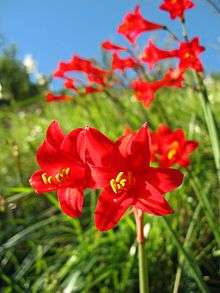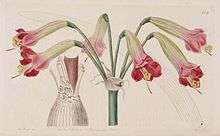Phycella
| Phycella | |
|---|---|
 | |
| Phycella cyrtanthoides | |
| Scientific classification | |
| Kingdom: | Plantae |
| Clade: | Angiosperms |
| Clade: | Monocots |
| Order: | Asparagales |
| Family: | Amaryllidaceae |
| Subfamily: | Amaryllidoideae |
| Genus: | Phycella Lindl.[1][2] |
| Species | |
|
see text | |
| Synonyms | |

Phycella is a genus of herbaceous, perennial bulbous flowering plants belonging to the family Amaryllidaceae, subfamily Amaryllidoideae. The genus consists of five species distributed from central Chile to northwestern Argentina.[6]
Taxonomy
The genus was described by John Lindley in 1825.[7][1] After further examining specimens of Amaryllis ignea (see illustration) that he had described the previous year as Amaryllis, with some reservation,[5] Lindley concluded they were a separte genus, naming two species, P. ignea, and P. cyrtanthoides (previously A. cyrtanthoides). Subsequently it was considered these were the same plant, and P. ignea was reassigned to a synonym for P. cyrtanthoides.[8]
Phylogeny
Phycella is located in the American (Hippeastroid) clade of the Amaryllidoideaetribe, where it is placed in tribe Hippeastreae, subtribe Traubiinae. In molecular phylogenetic analysis, Phycella forms a sister group to the remainder of the Hippeastreae.[9] In 1996 the Müller-Doblies' had situated it in subtribe Hippeastrinae based on morphological criteria, by submerging it in Hippeastrum.[10] A detailed study of in-depth relations within Hippeastreae revealed a more complicated situation wit regard to the Chilean-Argentinian taxa which had not been well represented in earlier studies. There was strong support for two major clades, representing two subtribes, with Phycella and three other genera (but not Hippeastrum) forming the Traubiinae. This study also showed that one species of Famatina (F. maulensis) segregated with Phycella, and was therefore submerged in it as Phycella herbertiana.[11] By contrast the remaining three Famatina species segregated with Rhodophiala and were therefore grouped in Hippeastrinae together with Hippeastrum. Consequently Famatina has been extinguished as separate genus.[12]
Subdivision
Five species are described:[13]
- Phycella australis Ravenna [14]
- Phycella brevituba Herb. [15]
- Phycella cyrtanthoides (Sims) Lindl.[1]
- Phycella herbertiana Lindl. [16] syn. Famatina maulensis Ravenna[11]
- Phycella scarlatina Ravenna [17]
References
- 1 2 3 4 Lindley 1825.
- ↑ WCLSPF 2015, Phycella
- ↑ Pl. Life 28: 56 (1972)
- ↑ Bot. Australis 2: 8 (2003)
- 1 2 Lindley 1824.
- ↑ TPL 2013, Phycella
- ↑ Tropicos 2015, Phycella
- ↑ WCLSPF 2015, Phycella ignea
- ↑ Meerow et al 2000.
- ↑ Müller-Doblies & Müller-Doblies 1996.
- 1 2 WCLSPF 2015, Famatina maulensis
- ↑ Garcia et al 2014.
- ↑ WCLSPF 2015.
- ↑ Pl. Life 37: 71 (1981)
- ↑ Amaryllidaceae: 154 (1837)
- ↑ Edwards's Bot. Reg. 16: t. 1341 (1830)
- ↑ Pl. Life 37: 69 (1981)
Bibliography
- The International Plant Names Index Phycella.
- "World Checklist of Selected Plant Families". Royal Botanic Gardens, Kew. Retrieved 8 August 2015.
- Lindley, John (1824). "Amaryllis ignea". The Botanical Register. 10: 809.
- Lindley, John (1825). "Note upon Amaryllis ignea Supra vol. 10. fol. 809". The Botanical Register. 11: ad 928.
- Müller-Doblies, U.; Müller-Doblies, D. (1996). "Tribes and subtribes and some species combinations in Amaryllidaceae J St Hil R Dahlgren & al. 1985". Feddes Repertorium. 107 (5–6): S.c.1–S.c.9.
- Meerow, A.W.; Guy, C.L.; Li, Q.-B.; Yang, S.-L. (2000). "Phylogeny of the American Amaryllidaceae Based on nrDNA ITS Sequences" (PDF). Systematic Botany. 25 (4): 708–726. doi:10.2307/2666729. Retrieved 25 January 2015.
- García, Nicolás; Meerow, Alan W.; Soltis, Douglas E.; Soltis, Pamela S. (1 March 2014). "Testing Deep Reticulate Evolution in Amaryllidaceae Tribe Hippeastreae (Asparagales) with ITS and Chloroplast Sequence Data". Systematic Botany. 39 (1): 75–89. doi:10.1600/036364414X678099.
- "The Plant List: a working list of all known plant species. Version: 1.1". Royal Botanic Gardens, Kew and Missouri Botanical Garden. September 2013.
- "Tropicos". Missouri Botanical Garden. 2015. Retrieved 30 December 2015.
| Wikimedia Commons has media related to Phycella. |
| Wikispecies has information related to: Phycella |